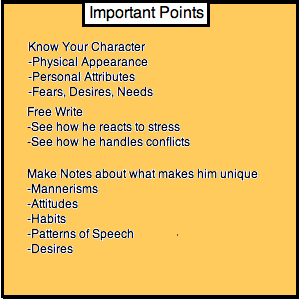|
Characterization: Building A Compelling CharacterEstablishing A Character Characterization is one of the keys to building a good fiction (or creative non-fiction) story. The better an author knows his character the more convincing the story can be. That’s why so many authors use the same characters over and over. The characters are alive in their own worlds and can pull themselves and the readers through the story with ease. Take, for example, John Updike’s protagonist Rabbit (Rabbit, Run (1960); Rabbit Redux (1971); Rabbit is Rich (1981); Rabbit At Rest (1990); and Rabbit Remembered (2001)). It was the third and fourth books of the connected stories that won the Pulitzers. By then, he knew Rabbit inside and out. In order to have really solid characterization, you need to get to know your characters intimantly. They have to start talking to you and that takes time. You have to supply the basics and set them in motion, pushing them through the story until they take it over. Start by building him from the ground up. When we meet someone for the first time we immediately begin to assess them and make judgments (you do whether you want to or not). Their clothing, hair, shoes, scars, expressions, posture; all of these are clues about their personality, their characterization. Do the same for the readers and hand them these clues so they can make their own judgments. After you’ve lead them to the judgments you think they'll make, you can have fun playing against them. 
Get the Picture Scratch his details out with a pencil or type away on an empty Word document. It doesn’t matter how its done, but don’t try to write complete sentences, just quick descriptions. Get a good picture of the character in your mind and write down his physical characteristics. Here is an example of the physical characterization sketch of a main character. “Hector, Black hair growing like a jungle, shoes the size of canoes, arms like broken tree branches, seems incapable of standing without slouching, smiles broadly showing a river of straight white teeth, wide fish eyes that never seem to blink, 5’11”, smooth, sun-baked skin.” Remember, these descriptions aren’t for the story, they’re for you to finalize the mental picture of your character. Next, to get to know your character better, make a list of things that are important to him. Again, you don’t need complete sentences here. “Values friendship, loyalty, envies success, rejects authority, believes in God, misplaces trust, fears rejection.” Notice that these characterization terms are fairly loose. If this person is new to you, chances are that you don’t really know how he feels specifically about each of these values, or even if he’s going to recognize them in himself. For example, while Hector will realize that he believes strongly in the value of loyalty, he probably won’t think a lot about how often he misplaces his trust. The two may make an interesting conflict at some point in the story. Who are you really? Now is the time to really get to know your character. If you already have at least a vague plot in mind, which you probably do at this point, put the character into a situation that happens outside of the story, before it takes place. Make up a quick scenario that will have no consequence directly on your story but will inform you about how the character acts under stress. Say, two months before the story, Hector gets pulled over for speeding. This writing has to be completely disposable. If you’re planning on inserting it at some point in the story you may become too attached to it and not associate as freely as you should. Now free write. Don’t think about what is going on in the story; you’re not trying to get to the next plot point, you’re learning about the character. Ignore spelling, grammar, syntax, and all the other elements that make the writing presentable. Just write. Don’t go back and read it yet. Try another situation. One of the major aspects of characterization is knowing how he'll react in a variety of situations. After you have a few scenes written go back and reread them. Look for similar reactions in different situations. Look for ways the characters acted unexpectedly. Try to pick up on the details that will set him apart from the archetype or stereotype of his character. Look for mannerisms, attitudes, habits, patterns of speech, and desires. These will be thing things that make him interesting to the reader. They can be taken and developed in the story. Get Your FREE Ebook How To Write And Get Paid For It when you join our mailing list. |
||
|
|
||